|
 |
| Adult male, Santa Cruz Island, Santa Barbara County |
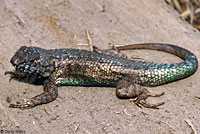 |
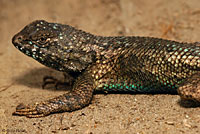 |
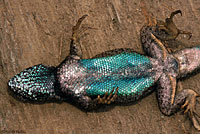 |
| Adult male, Santa Cruz Island, Santa Barbara County |
 |
 |
 |
Adult male, Santa Cruz Island,
Santa Barbara County |
Adult male, Santa Cruz Island,
Santa Barbara County
|
Adult male, Santa Cruz Island,
Santa Barbara County
|
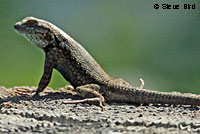 |
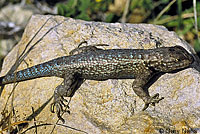 |
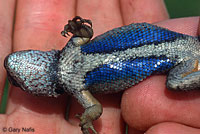 |
| Adult, Santa Cruz Island, Santa Barbara County © Steve Bird |
Adult male, Santa Cruz Island,
Santa Barbara County
|
Adult male, Santa Cruz Island, Santa Barbara County |
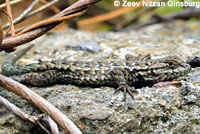 |
 |
| Adult, Santa Cruz Island, Santa Barbara County © Zeev Nitzan Ginsburg |
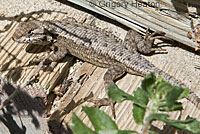 |
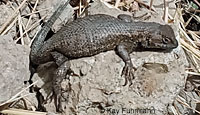 |
 |
| Adult, Santa Rosa Island, Santa Barbara County © Grigory Heaton |
Adult, Santa Cruz Island, Santa Barbara County © Kay Fuhrmann |
Juvenile, Santa Cruz Island,
Santa Barbara County |
| |
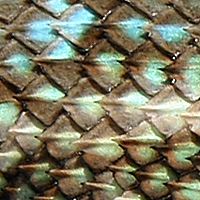 |
|
| |
Island Fence Lizards have overlapping keeled scales with spines on them over much of their body. |
|
| |
|
|
| Habitat |
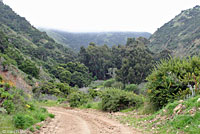 |
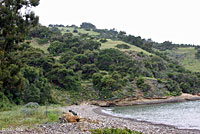 |
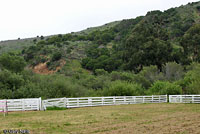 |
Habitat, Santa Cruz Island
|
Habitat, beach driftwood on
Santa Cruz Island |
Habitat, Santa Cruz Island
|
 |
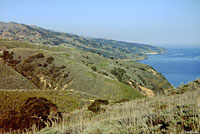 |
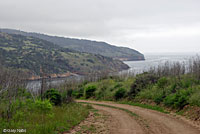 |
Habitat, Santa Cruz Island
|
Habitat, Santa Cruz Island
|
Habitat, Santa Cruz Island
|
|
|
|
| Description |
| |
| Size |
2.25 - 3.5 inches long from snout to vent (5.7 - 8.9 cm). (Stebbins 2003)
|
| Appearance |
A fairly small lizard with large overlapping keeled scales with spines on them on the back and sides.
Scales on the backs of the thighs are mostly keeled. |
| Color and Pattern |
Color is brown, gray, or black with blotches.
Sometimes light markings on the sides of the backs form stripes or irregular lines, and sometimes dark blotching may form irregular bands.
The rear of the limbs is yellow or orange.
The base color of the throat and underside are typically pale to dark gray and sometimes black. |
| Male / Female Differences |
Males have blue markings on the sides of the belly edged in black, a black patch on the throat, enlarged postanals, enlarged femoral pores, and a swollen tail base.
On some males the throat and dorsal coloring around the bright blue can be very dark.
Some scales on a male's back and tail become blue or greenish when he is in the light phase.
Females have faint or absent blue markings on the belly, no blue or green color on the upper surfaces, and dark bars or crescents on the back. |
| Young |
Juveniles have little or no blue on the throat and faint blue belly markings or none at all.
|
| Life History and Behavior |
Activity |
Diurnal.
Often seen basking in the sun on rocks, downed logs, trees, fences, and walls.
Prefers open sunny areas.
Active when temperatures are warm, becomes inactive during periods of extreme heat or cold, when they shelter in crevices and burrows, or under rocks, boards, tree bark, etc.
The mild climate of the islands this lizard inhabits probably allow activity all year.
Common and easily encountered in the right habitat.
This is probably the species of lizard most often seen in the state due to its abundance in and near populated areas and its conspicuous behavior. |
| Territoriality |
Males establish and defend a territory containing elevated perches where they can observe mates and potential rival males.
Males defend their territory and try to attract females with head-bobbing and a push-up display that exposes the blue throat and ventral colors. Territories are ultimately defended by physical combat with other males. |
| Defense |
The tail can break off easily, but it will grow back.
The detached tail wriggles on the ground which can distract a predator from the body of the lizard allowing it time to escape.
More information about tail loss and regeneration. |
| Diet and Feeding |
| Eats small, mostly terrestrial, invertebrates such as crickets, spiders, ticks, and scorpions, and occasionally eats small lizards including its own species. |
| Reproduction |
Adults breed in the spring of their second year.
Courtship and mating take place from late April to early June.
Egg laying occurs 2 - 4 weeks after copulation, usually from June to July.
Females lay 1-3 clutches of
3 - 17 eggs (averaging 8) in a season.
Females dig small pits in loose damp soil (often at night) where they lay the eggs.
Eggs have white leathery shells and measure 8 by 14 mm.
Eggs hatch in about 60 days, usually from July to September.
(Stebbins, 2003; Nussbaum et al, 1983)
|
| Western Fence Lizards and Lyme Disease |
The Island Fence Lizard is very similar to the Western Fence Lizard, and is considered by some authorities to be that species, so the following information about fence lizards and tics and Lyme disease might apply to the species.
In California, western black-legged ticks (deer ticks) are the primary carriers of Lyme disease. Very tiny nymphal deer ticks are more likely to carry the disease than adults. A protein in the blood of Western Fence Lizards kills the bacterium in these nymphal ticks when they attach themselves to a lizard and ingest the lizard's blood. This could explain why Lyme disease is less common in California than it is in some areas such as the Northeastern states, where it is epidemic.
More Information: (Berkeleyan April 1998)
In an interesting twist, UC Berkeley researchers have found that when fence lizards are removed from an area, the population of Lyme disease-carrying ticks plummets. Up to 90 percent of juvenile Western black-legged ticks, the species that carries the Lyme disease bacteria, feed on Western Fence Lizards. When lizards are no longer available, 95 percent of the ticks fail to find another host to feed on.
More Information: (Berkeley News February 2011)
|
| Habitat |
Prefers open sunny areas with elevated perching spots, including stream banks, beach driftwood, grassy hillsides, fences, and walls of human settlements.
|
| Geographical Range |
This species is endemic to California. Found only in the Channel Islands off the southern California coast on Santa Cruz, Santa Rosa, and San Miguel Islands.
|
| Notes on Taxonomy |
Formerly Sceloporus occidentalis becki - a subspecies of the Western Fence Lizard.
Some authorities have elevated this subspecies to the full species Sceloporus becki.
I have started following this taxonomy in January, 2025.
-------------------------------------------------------------------------------------------------------------------------------------------------------------------
Hansen and Shedd (2025) recognize the Island Fence Lizard as a distinct species, Sceloporus becki, citing a study by Salerno et al. (2023) which "...used mtDNA sequences and found deep genetic divergence from mainland populations, reflecting long isolation."
-------------------------------------------------------------------------------------------------------------------------------------------------------------------
This note is shown on the 2017 SSAR Scientific and Common Names list:
"Wiens and Reeder (1997, Herpetol. Monog. 11: 1–101) suggested that Sceloporus occidentalis becki should probably be recognized as a species on the basis of diagnosability and allopatry relative to other populations of S. occidentalis."
The taxonomy of Sceloporus occidentalis needs to be studied further. Six subspecies have been traditionally recognized based on geographic variation in morphology, but molecular studies have identified four major clades and eleven different genetic groups in California (James Archie, Cal State University Long Beach). The current taxonomy does not correspond with the ongoing research, so it is certain that in the future the current subspecies and their ranges will be completely revised, probably with several new species described. For this reason some experts no longer recognize any subspecies of S. occidentalis pending further studies.
-------------------------------------------------------------------------------------------------------------------------------------------------------------------
"Wiens and Reeder (1997, Herpetological Monographs 11: 1–101) suggested that Sceloporus occidentalis becki should be recognized as a species based on diagnosability and allopatry relative to other populations of S. occidentalis. Salerno et al. (2023, Journal of Biogeography 50: 116–129) confirmed monophyly of island populations using mtDNA and suggested S. becki constitutes a species."
(Nicholson, K. E. (ed.). 2025 SSAR Scientific and Standard English Names List)
-------------------------------------------------------------------------------------------------------------------------------------------------------------------
Alternate and Previous Names (Synonyms)
Commonly called: Bluebelly, Blue-bellied Lizard, Fence Lizard, Swift, Fence Swift
Sceloporus occidentalis becki - Island Fence Lizard (SSAR Names List 2017)
Sceloporus occidentalis - Western Fence Lizard (no subspecies recognized) (Stebbins 2003, 2018)
Sceloporus occidentalis becki - Island Fence Lizard (Stebbins 1966, 1985)
Sceloporus occidentalis becki - Channel Island Fence Lizard (Smith 1946)
Sceloporus occidentalis becki - Island Blue-bellied Lizard (Grinnell and Camp 1917)
|
| Conservation Issues (Conservation Status) |
| None |
|
|
Taxonomy |
| Family |
Phrynosomatidae |
Zebra-tailed, Earless, Fringe-toed, Spiny, Tree, Side-blotched, and Horned Lizards |
Fitzinger, 1843 |
| Genus |
Sceloporus |
Spiny Lizards |
Wiegmann, 1828 |
| Species |
becki |
Island Fence Lizard |
Van Denburgh, 1905 |
|
Original Description |
Sceloporus becki - Van Denburgh, 1905 - Proc. California Acad. Sci., Ser. 3, Zool. Vol. 4, No. 1, p. 9, pl. 4
from Original Description Citations for the Reptiles and Amphibians of North America © Ellin Beltz
|
|
Meaning of the Scientific Name |
Sceloporus - Greek - skelos = leg + porus = pore or opening - refers to the femoral pores on hind legs
becki - honors Rollo Howard Beck, collector of the holotype.
from Scientific and Common Names of the Reptiles and Amphibians of North America - Explained © Ellin Beltz
|
|
Related or Similar California Lizards |
Western Fence Lizards:
Sceloporus occidentalis biseriatus - San Joaquin Fence Lizard
Sceloporus occidentalis bocourtii - Coast Range Fence Lizard
Sceloporus occidentalis longipes - Great Basin Fence Lizard
Sceloporus occidentalis occidentalis - Northwestern Fence Lizard
Sceloporus occidentalis taylori - Sierra Fence Lizard
Sagegrush Lizards:
S. graciosus graciosus - Northern Sagebrush Lizard
S. graciosus gracilis - Western Sagebrush Lizard
S. vandenburgianus - Southern Sagebrush Lizard
|
|
More Information and References |
California Department of Fish and Wildlife
Hansen, Robert W. and Shedd, Jackson D. California Amphibians and Reptiles. (Princeton Field Guides.) Princeton University Press, 2025.
Stebbins, Robert C., and McGinnis, Samuel M. Field Guide to Amphibians and Reptiles of California: Revised Edition (California Natural History Guides) University of California Press, 2012.
Stebbins, Robert C. California Amphibians and Reptiles. The University of California Press, 1972.
Flaxington, William C. Amphibians and Reptiles of California: Field Observations, Distribution, and Natural History. Fieldnotes Press, Anaheim, California, 2021.
Nicholson, K. E. (ed.). 2025. Scientific and Standard English Names of Amphibians and Reptiles of North America North of Mexico, with Comments Regarding Confidence in Our Understanding. Ninth Edition. Society for the Study of Amphibians and Reptiles. [SSAR] 87pp.
Samuel M. McGinnis and Robert C. Stebbins. Peterson Field Guide to Western Reptiles & Amphibians. 4th Edition. Houghton Mifflin Harcourt Publishing Company, 2018.
Stebbins, Robert C. A Field Guide to Western Reptiles and Amphibians. 3rd Edition. Houghton Mifflin Company, 2003.
Behler, John L., and F. Wayne King. The Audubon Society Field Guide to North American Reptiles and Amphibians. Alfred A. Knopf, 1992.
Robert Powell, Roger Conant, and Joseph T. Collins. Peterson Field Guide to Reptiles and Amphibians of Eastern and Central North America. Fourth Edition. Houghton Mifflin Harcourt, 2016.
Powell, Robert., Joseph T. Collins, and Errol D. Hooper Jr. A Key to Amphibians and Reptiles of the Continental United States and Canada. The University Press of Kansas, 1998.
Bartlett, R. D. & Patricia P. Bartlett. Guide and Reference to the Turtles and Lizards of Western North America (North of Mexico) and Hawaii. University Press of Florida, 2009.
Jones, Lawrence, Rob Lovich, editors. Lizards of the American Southwest: A Photographic Field Guide. Rio Nuevo Publishers, 2009.
Smith, Hobart M. Handbook of Lizards, Lizards of the United States and of Canada. Cornell University Press, 1946.
Taylor, Emily. California Lizards and How to Find Them. Heyday, Berkeley, California. 2025.
Nussbaum, R. A., E. D. Brodie Jr., and R. M. Storm. Amphibians and Reptiles of the Pacific Northwest. Moscow, Idaho: University Press of Idaho, 1983.
Schoenherr, Allan A. Natural History of the Islands of California. The University of California Press. 2003.
Wiens & Reeder (1997 Herpetological Monographs 11: 1-101)
Bell (2001 Bulletin of the Maryland Herpetological Society 37(4): 137-142)
S. Morey. Western Fence Lizard Family: Phrynosomatidae R022. California Wildlife Habitat Relationships System California Department of Fish and Game. Originally published in Zeiner, D.C., W.F.Laudenslayer, Jr., K.E. Mayer, and M. White, eds. 1988-1990.
Joseph Grinnell and Charles Lewis Camp. A Distributional List of the Amphibians and Reptiles of California. University of California Publications in Zoology Vol. 17, No. 10, pp. 127-208. July 11, 1917.
|
|
|
The following conservation status listings for this animal are taken from the July 2025 State of California Special Animals List and the July 2025 Federally Listed Endangered and Threatened Animals of California list (unless indicated otherwise below.) Both lists are produced by multiple agencies every year, and sometimes more than once per year, so the conservation status listing information found below might not be from the most recent lists, but they don't change a great deal from year to year.. To make sure you are seeing the most recent listings, go to this California Department of Fish and Wildlife web page where you can search for and download both lists:
https://www.wildlife.ca.gov/Data/CNDDB/Plants-and-Animals.
A detailed explanation of the meaning of the status listing symbols can be found at the beginning of the two lists. For quick reference, I have included them on my Special Status Information page.
If no status is listed here, the animal is not included on either list. This most likely indicates that there are no serious conservation concerns for the animal. To find out more about an animal's status you can also go to the NatureServe and IUCN websites to check their rankings.
Check the current California Department of Fish and Wildlife sport fishing regulations to find out if this animal can be legally pursued and handled or collected with possession of a current fishing license. You can also look at the summary of the sport fishing regulations as they apply only to reptiles and amphibians that has been made for this website.
This animal is not included on the Special Animals List, which indicates that there are no significant conservation concerns for it in California.
|
| Organization |
Status Listing |
Notes |
| NatureServe Global Ranking |
|
|
| NatureServe State Ranking |
|
|
| U.S. Endangered Species Act (ESA) |
None |
|
| California Endangered Species Act (CESA) |
None |
|
| California Department of Fish and Wildlife |
None |
|
| Bureau of Land Management |
None |
|
| USDA Forest Service |
None |
|
| IUCN |
|
|
|
|
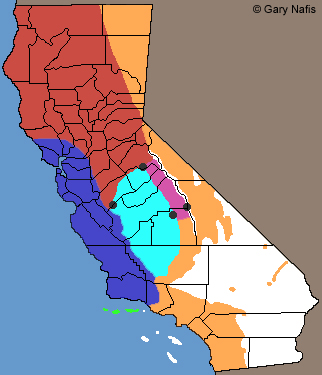 Bright Green: Range of this species in California
Bright Green: Range of this species in California






















